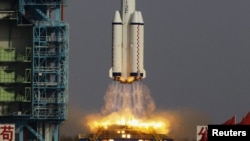China has conducted its first-ever manual docking between a spacecraft and an orbiting space module.
The three astronauts on the Shenzhou-9 spacecraft successfully docked with the Tiangong-1 lab module Sunday without using an automated system. One of the three is China's first female astronaut, Liu Yang.
The Shenzhou-9 spacecraft was launched June 16, and it docked with the space station module two days later in a successful automated procedure.
Officials say the more challenging manual docking will serve in the construction of a larger space station, which China aims to complete by 2020.
The Tiangong-1 is an experimental module that will stay in orbit until 2013.
Before China, the United states and the Soviet Union accomplished manual docking successfully in the 1960s.
The technique requires great accuracy, as it involves two objects placed in the same orbit and revolving around Earth at thousands of kilometers per hour. The craft and the module need to connect very gently to avoid destroying each other.
The 10-day mission is expected to last two more days.
The three astronauts on the Shenzhou-9 spacecraft successfully docked with the Tiangong-1 lab module Sunday without using an automated system. One of the three is China's first female astronaut, Liu Yang.
The Shenzhou-9 spacecraft was launched June 16, and it docked with the space station module two days later in a successful automated procedure.
Officials say the more challenging manual docking will serve in the construction of a larger space station, which China aims to complete by 2020.
The Tiangong-1 is an experimental module that will stay in orbit until 2013.
Before China, the United states and the Soviet Union accomplished manual docking successfully in the 1960s.
The technique requires great accuracy, as it involves two objects placed in the same orbit and revolving around Earth at thousands of kilometers per hour. The craft and the module need to connect very gently to avoid destroying each other.
The 10-day mission is expected to last two more days.
Some information for this report was provided by AP, AFP and Reuters.











